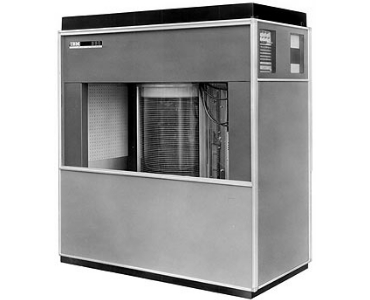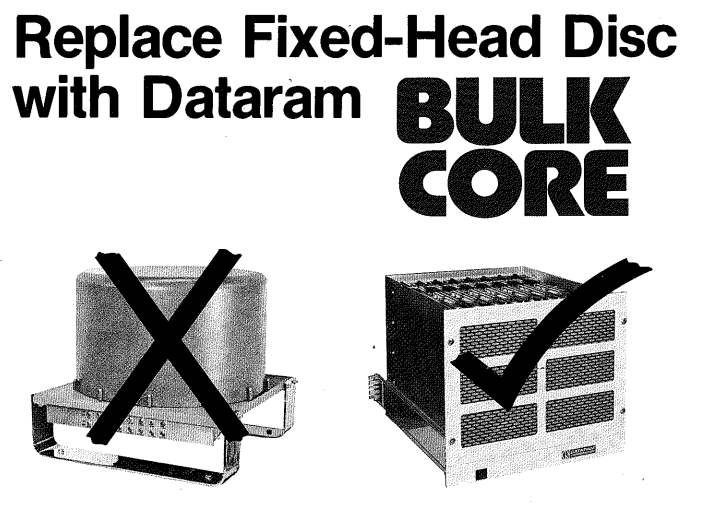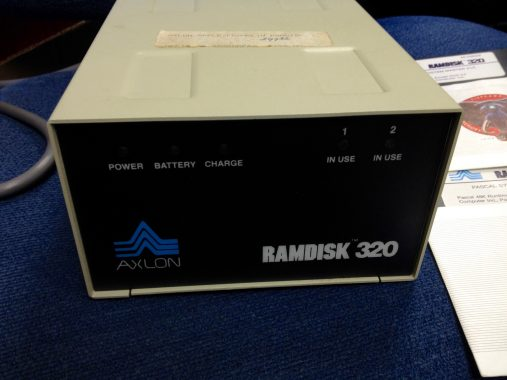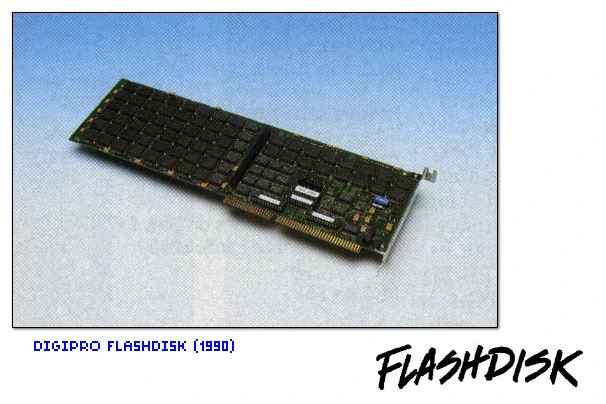
Studying the history of drives is the beginning of the path to understanding how solid state drives work. The first part of our series of articles “Introduction to SSD” will give an excursion into history and allow you to clearly understand the difference between SSD and its closest competitor - HDD.
Despite the abundance of various devices for storing information, the popularity of HDD and SSD in our time is undeniable. The difference between these two types of drives for the layman is obvious: SSDs are more expensive and faster, and HDDs are cheaper and more capacious.
Special attention should be paid to the unit of measurement of drive capacity: historically, decimal prefixes, such as kilo and mega, in the context of information technology, mean the tenth and twentieth power of two. To eliminate confusion, binary prefixes kibi-, mebel- and others were introduced. The difference between these consoles becomes noticeable with an increase in volume: when buying a 240 gigabyte disk, you can save 223.5 gibibytes of information on it.
Immersion in History

The development of the first hard drive has been underway since 1952 by IBM. On September 14, 1956, the final development result was announced - the IBM 350 Model 1. The drive contained 3.75 mebibytes of data with very immodest dimensions: 172 centimeters high, 152 centimeters long and 74 centimeters wide. Inside were 50 pure iron-coated thin discs with a diameter of 610 mm (24 inches). The average time to search for data on a disk took ~ 600 ms.
Time passed, and IBM confidently improved technology. In 1961, IBM 1301 was introduced with a capacity of 18.75 megabytes with read heads on each plate. IBM 1311 introduced removable disk cartridges, and since 1970, an error detection and correction system has been introduced in the IBM 3330. Three years later, the IBM 3340, known as the Winchester, appeared.
Winchester (from the English Winchester rifle) is the common name for rifles and rifles manufactured by the Winchester Repeating Arms Company in the USA in the second half of the 19th century. These were one of the first multi-shot rifles that gained immense popularity among buyers. They owed their name to the founder of the company, Oliver Fisher Winchester.
The IBM 3340 consisted of two spindles of 30 MiB each, which is why engineers called this disk “30-30” . The name was reminiscent of a Winchester Model 1894 rifle with .30-30 Winchester cartridges, which is why Kenneth Haughton, IBM 3340 development manager, said, “If it's 30-30, then it should be Winchester.” a 30-30, then it must be a Winchester. ”). Since then, not only rifles, but also hard drives have been called “Winchester”.
Three years later, the IBM 3350 Madrid came out with 14-inch wafers and an access time of 25 ms.

The first SSD drive was created by Dataram in 1976. The Dataram BulkCore drive consisted of a chassis with eight RAM slots of 256 KiB each. Compared to the first hard drive, BulkCore was tiny: 50.8 cm long, 48.26 cm wide and 40 cm high. The data access time in this model was only 750 ns, which is 30,000 times faster than the most modern HDD at that time.
In 1978, Shugart Technology was founded, which a year later changes its name to Seagate Technology in order to avoid conflicts with Shugart Associates. After two years of Seagate's work, the ST-506 is born - the first hard drive for personal computers in the 5.25-inch form factor and with a capacity of 5 MiB.
In addition to the advent of Shugart Technology, 1978 was remembered for the release of StorageTek's first Enterprise SSD. StorageTek STC 4305 contained 45 MiB of data. Designed as a replacement for the IBM 2305, this SSD was similar in size and cost an incredible $ 400,000.

In 1982, SSD entered the personal computer market. Axlon company specifically for Apple II is developing an SSD-drive on RAM-chips called RAMDISK 320. Since the drive was created on the basis of volatile memory, a battery was supplied to maintain the safety of information. The battery capacity was enough for 3 hours of battery life in case of loss of power.
A year later, Rodime will release the first 10 MiB RO352 hard drive in a 3.5-inch form factor familiar to the modern user. Despite the fact that this is the first commercial disc in such a form factor, Rodime essentially did nothing innovative.
The first product in this form factor is the floppy drive provided by Tandon and Shugart Associates. Moreover, Seagate and MiniScribe have agreed to adopt the 3.5-inch industry standard, leaving Rodime left behind, which awaits the fate of the patent troll and complete exit from the drive industry.

In 1980, Toshiba engineer, professor Fujio Masuoka, registered a patent for a new type of memory called Flash memory type NOR. Development took 4 years.
NOR-memory is a classic 2D matrix of conductors in which one cell is installed at the intersection of rows and columns (an analog of memory on magnetic cores).
In 1984, Professor Masuoka spoke about his invention at the International Electronics Developers Meeting, where Intel quickly appreciated the promise of this development. Toshiba, in which Professor Masuoka worked, did not consider Flash memory to be anything special, and therefore granted the request of Intel to make several prototypes for study.
Intel’s interest in developing Fujio prompted Toshiba to identify five engineers to help the professor solve the problem of commercializing the invention. Intel, in turn, threw three hundred employees to create its own version of Flash-memory.
While Intel and Toshiba were developing Flash drives, two important events took place in 1986. First, SCSI is officially standardized - a set of agreements for the interaction between computers and peripheral devices. Secondly, the AT Attachment (ATA) interface, known under the brand name Integrated Drive Electronics (IDE), was developed, thanks to which the disk controller moved inside the disk.
For three years, Fujio Mausoka worked on improving Flash technology and, by 1987, had developed NAND memory.
NAND memory is the same NOR memory organized in a three-dimensional array . The main difference was that the access algorithm for each cell became more complex, the area of cells became smaller, and the total capacity increased significantly.
A year later, Intel developed its own NOR-type flash memory, and Digipro built a flash drive called Flashdisk on it. The first version of Flashdisk in the maximum configuration contained 16 MiB of data and cost less than $ 500

In the late 80s and early 90s, hard drive manufacturers competed in downsizing. In 1989, PrairieTek launched the PrairieTek 220 20 MiB disc in a 2.5-inch form factor. Two years later, Integral Peripherals creates the Integral Peripherals 1820 Mustang with the same volume, but already 1.8 inches. A year later, Hewlett-Packard reduced disk size to 1.3 inches.
Seagate remained faithful to the 3.5-inch drive and relied on increased speed by releasing its famous Barracuda model in 1992, the first hard drive with 7200 rpm spindle speeds. But Seagate was not going to stop there. In 1996, Seagate Cheetah line drives reached a speed of 10,000 rpm, and four years later, the X15 modification spun up to 15,000 rpm.
In 2000, the ATA interface became known as PATA. The reason for this was the appearance of the Serial ATA (SATA) interface with more compact wires, support for "hot swap" and increased data transfer speed. Seagate took the lead here, releasing the first hard drive with such an interface in 2002.
Flash memory production was initially very expensive, but in the early 2000s, the cost dropped sharply. Transcend took advantage of this, in 2003 it released SSD disks in volumes from 16 to 512 MiB. Three years later, Samsung and SanDisk joined in mass production. In the same year, IBM sold its disk division to Hitachi.
SSDs were gaining momentum and there was an obvious problem: the SATA interface was slower than the SSDs themselves. To solve this problem, the NVM Express Workgroup began developing NVMe - a specification for access protocols to SSDs directly via the PCIe bus, bypassing the "intermediary" in the form of a SATA controller. This would allow access to data at a PCIe bus speed. Two years later, the first version of the specification was ready, and a year later the first NVMe drive appeared.
Differences between Modern SSDs and HDDs
At the physical level, the difference between SSDs and HDDs is easily noticeable: there are no mechanical elements in the SSDs, and information is stored in memory cells. The absence of movable elements leads to quick access to data in any part of the memory, however, there is a limit on the number of rewrite cycles. Due to the limited number of rewriting cycles for each memory cell, a need arises for a balancing mechanism - smoothing out the deterioration of cells by transferring data between cells. This work is done by the disk controller.
For balancing, the SSD controller needs to know which cells are busy and which are free. The controller is able to track the data recording into the cell itself, which cannot be said about deletion. As you know, operating systems (OS) do not erase data from the disk when the user deletes the file, but mark the corresponding sections of memory as free. This solution eliminates the need to wait for disk operation when using the HDD, but is completely unsuitable for SSD. The SSD controller works with bytes, not file systems, and therefore requires a separate message about deleting the file.
This is how the TRIM command appeared (eng. - trim), with which the OS notifies the SSD controller of the release of a certain area of memory. The TRIM command permanently erases data from disk. Not all operating systems are aware of the need to send this command to SSDs, and hardware RAID controllers in disk array mode never send TRIM disks.
To be continued…
In the following parts, we will talk about form factors, connection interfaces, and the internal organization of solid state drives.
In our Selectel Lab, you can independently test modern HDDs and SSDs and draw your own conclusions.